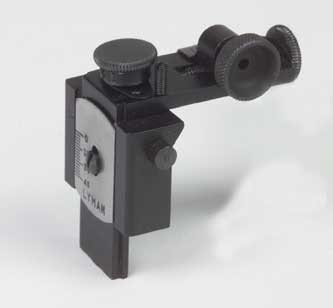|
Lyman Receiver "Peep" Sights By Chuck Hawks  The Lyman Company has been around since 1878. They are probably best known for their reloading supplies, reloading manual (in its 47th edition as I write these words) and their aperture sights. Peep sights were, in fact, the original product on which the company was founded. Lyman has manufactured a wide range of precision aperture sights for as long as I can remember. I first used a Lyman receiver sight on a Model 94 Winchester about 40 years ago. Then as now, the receiver sight offered a simpler and more accurate sight picture compared to standard open sights. The eye looks through the aperture, also sometimes called a peep or ghost ring (because it is blurry), making no attempt to focus on the rear sight. Focus is required only for the front sight and target. The eye will automatically peep through the center of the aperture without conscious thought. The U.S. military adopted this more accurate type of sight before World War I and practically all major powers eventually adopted the aperture sight. The rear aperture sight is still the standard aiming system for most military rifles around the world, which means that hundreds of thousands of individuals who have served in the military are familiar with its use; as well, of course, as the thousands of civilian hunters who have used them since the late 19th Century. Lyman offers their Model 57 series receiver sight for the Remington 700, Savage 110, and Winchester Model 70 rifles. The Model 66 series is for the Browning/Winchester Model 1886, Marlin 39, Marlin 336, Marlin 1894 and Winchester pre-angle eject Model 94 lever action rifles, as well as shotguns with flat receivers. The Model 90MJT is a target sight for most bolt action .22 rifles. The aperture sight is not as common on hunting rifles as it once was. Telescopic sights, which put the target and aiming mark in a single sighting plane, having become the preferred sighting system for most hunting purposes. Still, the aperture sight has its place in the scheme of things. One popular application is on pre-angle eject Model 94 Winchesters. These are perhaps the best handling hunting rifles ever produced, but they are awkward to scope. And a scope interferes with carrying them in one hand, grasped around the receiver, the most natural method. A receiver sight solves both of these problems and is far superior to the open sights supplied with the rifle. Thus it is that the specific model of Lyman receiver sight chosen for review is the 66A, mounted on a pre-angle eject Model 94 Winchester rifle. Like all Lyman receiver sights, the Model 66A incorporates 1/4 MOA click adjustments for windage and elevation and comes with two interchangeable (screw-in) aperture discs, one for target shooting and one for hunting. The sight is mounted to its base by means of a quick release slide that allows removal of the sight and its return to the same point of aim when it is reattached. This feature allows the Lyman receiver sight to be used as a backup sight on scoped rifles fitted with a quick detachable scope mount, and it is often used in just this way on African "safari" rifles. The pre-angle eject Winchester Model 94 rifles were drilled and tapped for receiver sights, so all the user has to do is mount the sight base to the left side of the receiver, using the two provided screws, and slide the sight into the base. Anyone, even I, can accomplish this minimal chore in a couple of minutes. The hardest part of the whole operation is removing the original rear sight from its dovetail grove so that it does not interfere with the new receiver sight. A hammer and a brass or hardwood drift pin is recommended for this chore. Lyman and others offer folding leaf rear sights that can be used to fill the empty dovetail if desired. This is purely a cosmetic matter, as the empty dovetail does no harm. Once the aperture sight is mounted on the rifle and bore sighted, it is ready to be sighted-in at the range. The 1/4 minute of angle click adjustments make sighting-in easy. As always, I recommend starting at 25 yards to make sure that the bullets at least hit the paper. Get the sight set dead on at 25 yards, and then move back to 100 yards for final sight adjustment. The "Rifle Trajectory Table for Iron Sights," which can be found on the Tables, Charts and Lists Page, has trajectory information for most common calibers and loads. In the case of a .32 Winchester Special rifle shooting a 170 grain bullet at a MV of 2250 fps, the load I was using in the test rifle, set the sights to put the bullet 2.9" high at 100 yards. The maximum point blank range (+/- 3") is then 209 yards. This is as far, or farther, than I want to shoot with any type of iron sights. The proof is in the shooting. The Lyman receiver sight cut my 100 yard group size about in half. The ultra precise Lyman is arguably the best receiver sight on the market. Its MSRP is also among the highest, at $72 (in 2004) direct from Lyman. Visit the Lyman web page to place an order. The precision, all steel, construction of the Lyman 66 receiver sight is confidence inspiring. A world of difference is evident when a Lyman receiver sight is compared to the cheap open sights supplied with most rifles. The Lyman's precise windage and elevation adjustments alone will probably save you the cost of the sight in ammunition saved the first time the rifle is sighted-in. |